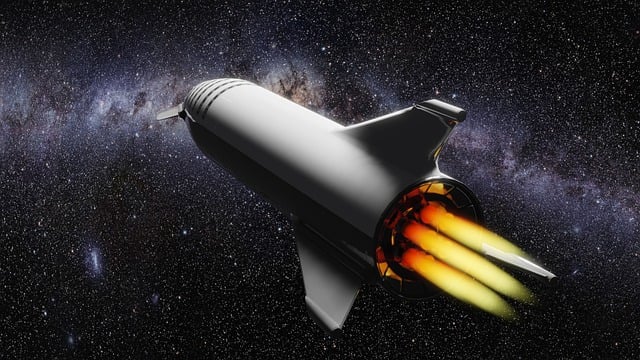SpaceX Starship took off in the flaring smoke and streaming fire on a clear night in South Texas. At that time the border between science fiction and reality disappears the giant stainless-steel rocket flying towards the horizon had not only cargo, but a hope of humanity in terms of the multiplanetary life.
Starship is by no means the least ambitious, radical space vehicle known to humanity. It is meant to be fully reusable, both Earth-to-Earth, landing on the Moon, and Mars, and a radical reinvention of space travel. It is a result of more than ten years of ingenuity, experimentation, and the trial and error paradigm. This is a rocket family, which is expected to transform how we get along with space. Starship itself is a topic worthy of deeper inquiry: its conception, the technological masterpieces designed into it, its performance during testing, difficulties it has encountered, and the remarkable breakthroughs it represents.
Table of Contents
A Vision That Rocketed Forward
The maverick founder of SpaceX Elon Musk has unveiled the vision of Starship more than 10 years ago. He mentioned in 2011 a large new launch vehicle to transport humans and supplies to Mars. It was ambitious but unspecific in the past, driven by desire to have multi planetary life. Starship was thus changed as SpaceX placed a metamorphosis. The idea went through a stage of drawings on paper to stainless-steel prototypes soar above the Texas scrub.

The initial design iterations passed through various names- some were referred to as “BFR” (Big Falcon Rocket), others were the so-called “ITS” (Interplanetary Transport System) and lastly, it was known as Starship. All along, the goal was unwavering: build a fully reusable launch vehicle with the capacity to deliver more than 100 metric tons (merely 10 times more than SpaceX Falcon 9) to orbit.
The Steel Giant: Design and Architecture
Modular Duo
Starship’s architecture is elegantly simple yet remarkably powerful. The system consists of two stages, each built from stainless steel alloys that glow brightly under the launchpad’s lights:
- Super Heavy: The booster stage—over 70 meters tall, weighing over 3,400 tonnes fully fueled. It’s powered by up to 33 Raptor engines, delivering roughly 72 MN of sea-level thrust.
- Starship: The upper stage—about 50 meters tall, designed to serve as both spacecraft and second stage. With six Raptors (three optimized for vacuum, three for sea level), it can transport up to 150 metric tons to Earth orbit, or carry crews and cargo to Mars.
Stainless Steel: A Strategic Choice
Rather than exotic carbon composites, SpaceX opted for stainless steel—heavy compared to aluminum-lithium or carbon fiber, but far more affordable and easier to weld. Critically, its high melting point enables forgoing heavy thermal protection blankets until final iteration. That said, exceptional thermal design and hot-gap shielding remain essential to survive reentry heating.
Raptor Engines: The Heart of Starship
Starship’s power lies in its Raptor family—full-flow staged combustion methalox engines. First-of-their-kind in full-flow configuration, Raptors deliver dramatically improved efficiency (over 380 s vacuum I_sp) and thrust-to-weight ratio. Both Super Heavy and Starship utilize Raptors, making SpaceX one of the few companies globally mastering the manufacturing of this engine class.

Trial by Fire: Testing Soars and Stumbles
SpaceX’s testing philosophy revolves around rapid iteration—prototype, test (often to destruction), learn, and improve. This fly-fast, break-fast mantra has accelerated Starship’s development significantly.
Hopper and Low-Hop Tests
It started modestly, with “Starhopper,” a small steel test vehicle conducting low-altitude (up to 150 m) hops. Between 2019 and 2020, Starhopper demonstrated Raptor engine viability and guidance systems execution. These “hop” tests built both engineering insight and public excitement—the future was taking shape.
High-Altitude Flights: Sharp Lessons
Using full-scale Starship prototypes (SN8 through SN15), SpaceX shifted to high-altitude tests reaching 10–12 km. These flights included challenging maneuvers: the belly flop descent and flip transition to upright landing attitude.
- SN8 crashed hard on landing—too much speed.
- SN9’s attempt ended with engine failure mid-turn.
- SN10 landed softly but exploded minutes later due to pressure issues.
- SN11 malfunctioned in mid-flight, exploding in a massive fireball.
- SN15 executed the full profile, landing softly and remaining intact—a triumphant milestone.
These tests demonstrated the gravity of SpaceX’s approach: fail fast, learn fast, repeat.
Triumphs and Setbacks: Tragedy Breeds Knowledge
Starship’s test vehicles have faced their share of spectacular failures. But each setback offers crucial lessons:
- SN8–SN11 flights revealed reentry control and landing transition complexities.
- SN15’s success showed design refinements—significantly stronger legs, improved flap hydraulics, enhanced avionics integrity.
- More recent tests have focused on combined Super Heavy and Starship operations, splashdown testing, and pathfinding reentry strategies.
SpaceX is unafraid to lose hardware. Instead, they celebrate data gained—each explosion or failure is a fountain of engineering insight.
Super Heavy Maiden Launch: A Monumental Step
June 2025 marked one of Starship’s most ambitious tests yet: the combined Super Heavy and Starship first integrated launch vehicle. At Boca Chica (now Starbase), the 120-meter twin-stack roared to life.
The launch was powerful—dozens of Raptors igniting simultaneously. The rocket achieved liftoff, clearing the pad with dramatic intensity. However, closer to Mach and Max-Q, multiple Raptors failed to reach full throttle or shut down prematurely. The ascent suffered early control issues. High drag and engine loss triggered a flight termination via S-band destruct, ending in pieces falling into the Gulf of Mexico.
Though the flight ended early, it accomplished several critical objectives:
- Verified structural resilience of twin-stack launch.
- Gathered real-world data on plume interaction, stage separation, and engine restart viability.
- Showed ground teams could coordinate launch and flight termination protocols successfully.
Despite the explosive finale, SpaceX engineers celebrated. The launch had confirmed key assumptions, charting next design advances.
Earth‑to‑Earth Point‑to‑Point Travel
Starship isn’t only about Mars. Musk’s early vision includes Earth‑to‑Earth point‑to‑point (PTP) transport—reducing global travel times drastically. Imagine traveling from New York to Tokyo in under an hour via a ballistic hop across the Pacific.
Engineering challenges are significant—like fast atmospheric ascent/descent, sonic booms, and safe reentry over populated areas. Yet SpaceX continues work on hypersonic lift-to-drag profiles, heat shielding, and G-force tolerance. Commercialization could eventually transform our global mobility landscape.
Lunar Ambitions and Artemis
NASA selected Starship as its Human Landing System (HLS) for returning astronauts to the Moon under Artemis. The plan includes multiple missions:
- Uncrewed demonstration: Starship lands near the lunar South Pole, testing descent, surface stay, refilling.
- Crewed mission: Astronauts dock with Starship in lunar orbit, descend to the surface, then return to the Orion spacecraft for Earth return.
Starship provides unprecedented payload and crew capacity—enabling development of lunar bases, sustained operations, and scientific exploration at scale.
Mars: The Endgame
Mars is Starship’s north star. Musk’s roadmap shows building a self-sustaining city on Mars within decades—requires hundreds of Starships ferrying:
- Cargo, rovers, habitat modules.
- Propellant manufacturing units (to produce methane and oxygen on Mars).
- Human settlers and supplies.
Challenges are immense: radiation protection, life support, agriculture, civil infrastructure—but Starship provides the heavy-lift backbone to enable an ambitious Martian program.
A critical demonstration mission projected for late 2020s involves sending an uncrewed Starship to Mars to validate entry, descent, and landing, and to test ISRU (in‑situ resource utilization). A crewed flight could follow in the early 2030s.
Tech Roadblocks and How SpaceX Addresses Them
- Reusability: Super Heavy’s return, Starship’s controlled belly flip and landing—both require robust hardware and real‑time precision. SpaceX built quad redundant avionics, heavier landing legs, advanced flaps, improved autonomy.
- Thermal protection: Stainless steel needs heat shielding for orbital reentry. SpaceX experiments with hot-gap insulation, ceramic tiles, ablative patches. Frequent reuses test ablative integrity.
- Engine reliability: Raptors are complex, and dozens fire at once. Quality control, factory automation, and hot‑fire testing refine reliability. Post-flame-out analysis helps improve components.
- Infrastructure scale: Starbase features full vehicle production bays, Super Heavy test stand, assembly tower, launch mount, and tank farms. Scaling operations has been a major engineering and logistical feat.
- Regulation and environment: Boca Chica operations face FAA, NASA, and local regulations, plus weather-related delays and wildlife concerns. SpaceX engages proactively with agencies and community.
Economic Implications
Starship’s cost model is transformational:
- Fully reusable system reduces cost per kilogram dramatically compared to expendables like Falcon 9, Ariane 5, or Delta IV Heavy.
- Heavy payload and crew capacity enables new markets: high‑bandwidth satellite mega‑constellations, space‑based telescopes, interplanetary cargo, deep‑space missions.
- Earth PTP travel opens aviation-scale markets—if safety and public acceptance follow.
- Government and commercial demand for lunar and Martian payload delivery could early justify manufacturing ramp-up.
A stable, frequent launch cadence (dozens per year) could also catalyze space infrastructure industries globally.
Competition and Global Context
SpaceX leads in super-heavy, fully reusable launch vehicles. Blue Origin’s New Glenn and ULA’s Vulcan will offer partial reuse at best. NASA and ESA continue with smaller rockets, but only Starship aspires for true full reusability on a massive scale.
International agencies like JAXA, Roscosmos, ISRO, and CNSA are researchers and developers, but none currently match Starship’s scale or ambition. China’s CZ-9 (Long March 9) aims for heavy lift, but reusability is less central.
In satellite launch, small- to medium-lift competitors exist; but deep-space, lunar, and interplanetary contexts firmly hint at Starship’s first-mover advantage.
What Lies Ahead: The Next Missions
1. Successive Hop Tests
Upcoming tests will refine Super Heavy landing attempts, integrate stage separation, and perfect engine restarts.
2. Orbital Trials
Later 2025 is projected for another integrated launch—aiming for longer flights past Mach 7, hot-stage separation, and high‑velocity reentry paths.
3. Space Station Cargo & Crew
Requests for ISS delivery missions and private space station servicing may come soon—using Starship’s high payload capacity.
4. Artemis HLS Missions
NASA’s first Starship lunar lander could launch in late 2020s, carrying astronauts to build a sustainable lunar presence.
5. First Mars Endeavors
By early 2030s, a fleet of Starships towards Mars could initiate surface operations and ISRU experiments, marking the start of humanity’s red-planet civilization.
Conclusion
Starship stands at the crossroads of imagination and infrastructure—a machine built not just to reach a destination, but to redefine what destinations even mean. From its steel backbone and Raptor heart to its audacious test philosophy, it represents humanity’s capacity for risk, creativity, and perseverance. As Starship engines fan into life again, we watch not just a rocket, but our collective ambition, pitch the heavens.
Whether transporting astronauts to the lunar south pole or sending the first Martian settlers, Starship’s mission transcends distance—it is an invitation. To dream. To explore. To dare. Soon, when the next launch lights up the Texas sky, we’ll be there to witness the next chapter in humanity’s long journey beyond Earth—propelled by stainless steel, fire, and boundless curiosity.
Kindly visit our website for more details.

